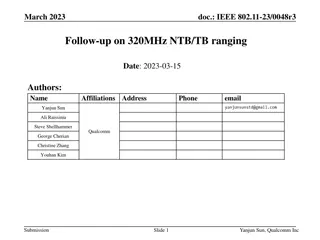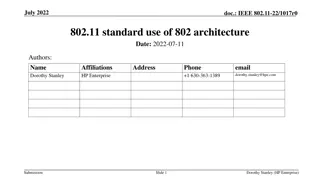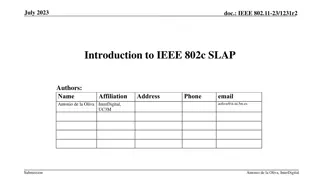Proposal for OTA MAC Change in IEEE 802.11-23/268r1
This proposal suggests using separate and unrelated random OTA MAC addresses for Source Address (SA) and Destination Address (DA) to enhance privacy and security in IEEE 802.11 networks. By obscuring the relationship between traffic, it aims to improve transmission privacy for multiple STAs associated with an AP. While providing advantages in privacy, it also highlights challenges in breaking the traditional assumption where DA and SA have the same value.
Download Presentation

Please find below an Image/Link to download the presentation.
The content on the website is provided AS IS for your information and personal use only. It may not be sold, licensed, or shared on other websites without obtaining consent from the author.If you encounter any issues during the download, it is possible that the publisher has removed the file from their server.
You are allowed to download the files provided on this website for personal or commercial use, subject to the condition that they are used lawfully. All files are the property of their respective owners.
The content on the website is provided AS IS for your information and personal use only. It may not be sold, licensed, or shared on other websites without obtaining consent from the author.
E N D
Presentation Transcript
doc.: IEEE 802.11-23/268r1 May 2023 Proposal for OTA MAC Change Authors: Date: 2023-05-15 Name Affiliations Address Phone Email Carol Ansley Cox Communications +1-404-229-1672 carol@ansley.com Submission Carol Ansley, Cox
doc.: IEEE 802.11-23/268r1 May 2023 Abstract This submission expands on ideas for OTA MAC Address change while a STA is associated for non-MLD STAs Submission Carol Ansley, Cox
doc.: IEEE 802.11-23/268r1 May 2023 Summary Allowing OTA MAC addresses, such as the SA and DA, to change separately would improve the privacy of transmissions by making it more difficult to correlate the downstream and upstream transmissions to a STA. Using a EDP Active bit can allow STAs to understand which devices can support MAC transition during association. Using an OTA MAC Change Count field in a Beacon frame can allow STAs to ensure synchronization with the AP. The need for more bits is TBD. Submission Carol Ansley, Cox
doc.: IEEE 802.11-23/268r1 May 2023 Requirements The following requirements all deal with changing a STA s OTA MAC address. 11bi shall define a mechanism for a CPE Client to change its own OTA MAC Address when reassociating from a CPE AP to another CPE AP. 6 11bi shall define a mechanism for a CPE Client to initiate changing its own OTA MAC Address used with a CPEAP inAssociate STAState 4 without any loss of connection. 7 11bi shall define a mechanism for a CPE AP to initiate changing the OTA MAC Addresses of a set of associated CPE Client s in the BSS (those CPE Clients in Associate STAState 4) without any loss of connection. 8 11bi shall define a mechanism for a CPE Client and CPE AP to establish the CPE Client s DS MAC Address without the CPE Client s DS MAC Address being transmitted in the clear. 12 11bi shall define a mechanism for a BPE AP and a BPE Client to change the OTA MAC addresses, SN and PN they use for unicast transmissions. 39 Submission Carol Ansley, Cox
doc.: IEEE 802.11-23/268r1 May 2023 MAC change while associated Proposal: Use separate unrelated random OTA MAC addresses for SA and DA values for a STA. For clarity, I ll name the MAC addresses from the perspective of the STA they refer to: SMAC is used by the STA for its outgoing transmissions. DMAC is used by the STA to set up its receive address filtering. From the perspective of the AP (assuming the STA is a non-AP STA), the DMAC is used for its transmissions to the STA, and the SMAC is used to identify transmissions from that STA. Advantages: Using unrelated values for DA and SA obscures the relationship between traffic when there is more than one STA associated to an AP. For example in [2], it discusses the captured traffic is sorted using the device MAC address Disadvantage: Device design has assumed for a long time that the DA and SA are the same value. Breaking that paradigm may be challenging. Submission Carol Ansley, Cox
doc.: IEEE 802.11-23/268r1 May 2023 Based on table 9-58, REVme D3.0 To DS From DS A1 A2 A3 MSDU and Short A- MPDU A3 Basic A-MSDU and Dynamic A- MSDU A4 - MSDU and Short A-MPDU A4 Basic A-MSDU and Dynamic A- MSDU Non- infrastru cture BSS, TDLS 0 0 RA=DA TA=SA BSSID BSSID N/A N/A Frame to STA 0 1 RA=DA->DMAC TA=BSSID SA BSSID N/A N/A Frame from STA 1 0 RA=BSSID TA=SA->SMAC DA BSSID N/A N/A MESH 1 1 RA TA DA BSSID SA BSSID DA field identifies the MAC entity that is the final recipient of the MSDU or A-MSDU frame. SA field identifies the MAC entity that initiated the frame. RA field identifies the immediate recipient of the frame on the WM. TA field identifies the STA that transmitted the frame onto the WM. There was a question with r0, should the SA/DA be obscured? Generally, the default GW(layer 3) is the SA for inbound frames and the DA for outbound frames. It does not seem useful to try to obscure that information since all the traffic will share the address. Submission Carol Ansley, Cox
doc.: IEEE 802.11-23/268r1 May 2023 Example Text Change for Notes of Table 9- 58 NOTE 1 The Address 1 field of a frame with the To DS subfield equal to 0 and the From DS subfield equal to 1 is equal to the DA, except when a frame containing an A-MSDU is used (for DMS, DMG relay or S1G relay the frame is individually addressed; for GCR, it is (group) addressed to the GCR concealment address), (#274)in which case the destination address of the MSDU is indicated in the DA or Mesh DA field of the A-MSDU subframe (see 11.21.16 (Group addressed transmission service), 10.11 (A-MSDU operation), 10.44 (DMG relay operation), 10.53 (S1G relay operation), and 10.64 (Addressing of GLK Data frame transmission)). When Enhanced Data Privacy is active at the STA and the AP, the Address 1 field is equal to the DMAC of the destination STA. In an MBSS, this is the only combination used for group addressed Data frames, and a combination only used for group addressed Data frames (see Table 9-3 (Combinations of To DS subfield and From DS subfield in Data frames(#278)), Table 9-4 (Combinations of To DS and From DS subfields in Management frames(#278)), and Table 9-75 (Address field contents for mesh Data and Multihop Action frames(#462)(#419))). NOTE 2 (#462)The Address 2 field of a frame with (#278)the To DS subfield equal to 1 and the From DS subfield equal to 0 is equal to the SA, except when an individually addressed frame containing an A-MSDU is used in GLK, DMG relay or S1G relay, (#274)in which case the source address of the MSDU is indicated in the SA or Mesh SA field of the A-MSDU subframe (see 10.11 (A-MSDU operation), 10.44 (DMG relay operation), 10.53 (S1G relay operation), and 10.64 (Addressing of GLK Data frame transmission)). When Enhanced Data Privacy is active at the STA and the AP, the Address 2 field is equal to the SMAC of the destination STA. In an MBSS, this combination is not used for Data frames (see Table 9-3 (Combinations of To DS subfield and From DS subfield in Data frames(#278)) and Table 9-75 (Address field contents for mesh Data and Multihop Action frames(#462)(#419))). Submission Carol Ansley, Cox
doc.: IEEE 802.11-23/268r1 May 2023 Trigger and Synchronization of OTA MAC change while associated To allow for a STA to synchronize its OTA MAC addresses with the AP, a new field in the Beacon frame is proposed called the OTA MAC Change Count field. When the counter increments, it signals to all STAs that a change has happened. If a STA has been dozing or lost communication briefly or suffered a restart, thus missing an OTA MAC address change, the STA can discover that it is out of sync with the AP by checking the OTA MAC Change Count field in the Beacon frame. Each time the KEY is changed or reinitialized, the OTA MAC Change Count field is cleared. Each time an OTA MAC change is executed, the counter is incremented. Since the sequence of MAC addresses linked to a STA is fixed once the KEY and starting STA MAC address is known, a STA can consult the OTA MAC Change Count field to find out how many iterations of the MAC address generation utility must be run to get back in sync with the AP. For example, if the STA last knew that the OTA MAC Change Count field was at 501 and then sees the field is at 503, it knows that it must take the OTA MAC information from instance 501 and iterate the OTA MAC generation algorithm twice to get back in sync with the AP, assuming that the KEY is unchanged. Submission Carol Ansley, Cox
doc.: IEEE 802.11-23/268r1 May 2023 Example change sequence STA AP STA associates/authenticates with AP and shared KEY is known to both, as well as initial STA OTA MAC (MAC1) STA indicates to AP that it supports MAC Change While Associated (EDP Active bit = 1) (MAC1) AP initiates MAC change by incrementing the OTA MAC Change Count field Queues are emptied in both directions using previous MAC1 To DS From DS STA transmits new traffic to AP using (SMAC1) as SA=TA 1 0 To DS From DS AP transmits new traffic to STA using (DMAC1) as DA=RA 0 1 Note that initial STA OTA MAC may be a randomized MAC address, TGbh content may provide a translation from the initial OTA MAC address and the MAC address the AP should use for packets heading into the DS Submission Carol Ansley, Cox
doc.: IEEE 802.11-23/268r1 May 2023 MAC generation In 11-22/114r3, the following formula was proposed: @MAC (n+1) = PRF-128/46(ERCM Key, ERCM , @MAC(n), 128) Where the ERCM key is passed in a separate action frame exchange, and the leftmost 46 bits are selected. Since several keys are already available, the following is proposed: @PairMAC (n+1) = PRF-128/92(KEY, PairMAC , @PairMAC(n), 128) Where KEY is the current Pairwise Transient Key, or the Key Encryption Key The leftmost 46 bits are selected for SA MAC used to TX from a non-AP STA The next 46 bits are selected for the DA MAC used for traffic to the same non-AP STA. Using an existing key avoids additional messaging exchanges. Changing the SA and DA MACs separately removes the linkage between DS and US traffic. Another point to consider about this approach is that we could include other parameters in the field being generated, such as the SN/PN which will need to change at the same time, unless we adopt a new method for the generation of SN/PN (see 23/328). Submission Carol Ansley, Cox
doc.: IEEE 802.11-23/268r1 May 2023 OTA MAC change while associated Proposal: STA indicates to other STAs that it can support a MAC Change while associated by setting the Enhanced Data Privacy (EDP) Active to 1. A STA can avoid OTA MAC change while associated by not including that bit or setting it to 0. For instance, if a STA cannot support a transition, it can clear the bit until it can support such a transition. If an AP STA sets the bit, then any associated STAs that also support this feature should be prepared for a transition to begin unless they have set their EDP bit to 0. If an AP has only one STA with EDP active, the AP may choose to put off changing OTA MAC address until there are at least 2 STAs supporting the feature. Submission Carol Ansley, Cox
doc.: IEEE 802.11-23/268r1 May 2023 Straw Poll 1 Is the group interested in text to separate the SA and DA for OTA MAC address rotation? Submission Carol Ansley, Cox
doc.: IEEE 802.11-23/268r1 May 2023 Straw Poll 2 Is the group interested in text for the use of a Beacon frame field called the OTA MAC Change Count field to announce and track the process of MAC changes? Submission Carol Ansley, Cox
doc.: IEEE 802.11-23/268r1 May 2023 References [1] 11-22/114r3 Enhanced Random and Changing MAC Address [2] The Dark Side(-Channel) of Mobile Devices: A Survey on Network Traffic Analysis, IEEE Communications Surveys & Tutorials, Vol. 20, Issue 4. pp 2658-2713, 2018. Submission Carol Ansley, Cox






















